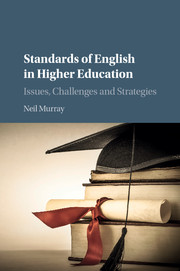Book contents
- Frontmatter
- Dedication
- Contents
- List of figures and tables
- Acknowledgements
- List of acronyms and abbreviations
- Introduction
- 1 The ‘English language question’ in the context of the changing face of higher education
- 2 English language: the need for and impact of policy and regulation
- 3 Seeking definitional clarity: what is ‘English language proficiency’?
- 4 Pre-enrolment language assessment and English language conditions of entry
- 5 Post-enrolment language assessment: challenges and opportunities
- 6 From assessment to provision
- 7 Innovation in English language provision: driving and navigating institutional change
- 8 Innovation in English language provision in higher education: an Australian case study
- References
- Appendices
- Index
6 - From assessment to provision
Published online by Cambridge University Press: 05 November 2015
- Frontmatter
- Dedication
- Contents
- List of figures and tables
- Acknowledgements
- List of acronyms and abbreviations
- Introduction
- 1 The ‘English language question’ in the context of the changing face of higher education
- 2 English language: the need for and impact of policy and regulation
- 3 Seeking definitional clarity: what is ‘English language proficiency’?
- 4 Pre-enrolment language assessment and English language conditions of entry
- 5 Post-enrolment language assessment: challenges and opportunities
- 6 From assessment to provision
- 7 Innovation in English language provision: driving and navigating institutional change
- 8 Innovation in English language provision in higher education: an Australian case study
- References
- Appendices
- Index
Summary
Introduction
Taking as my point of departure the tripartite conceptualisation of English language proficiency articulated in Chapter 3 and comprising general proficiency, academic literacy and professional communication skills, in this chapter I seek to present some of the considerations, constraints and opportunities likely to arise in the process of implementing, within the higher education context, a model of English language provision that draws on that framework. While I would not presume to offer an ‘ideal’ model of language provision, I hope that, even where readers may be unsympathetic to my conceptualisation, they nonetheless derive some benefit from the analysis offered of factors impacting on the implementation of this particular model and some of the general principles and considerations that emerge and which promise to inform other such initiatives involving curriculum innovation (see also Chapter 7) in respect of English language.
Over the next few pages, I will look specifically at the notion of embedding academic literacies and of providing academic literacy support through extra-curricular means; different permutations for delivering general proficiency tuition; and the question of how to structure such provision, both administratively and managerially, in an effort to ensure that it is maximally effective in achieving its purpose. I shall begin by looking at the last of these issues, as this inevitably impacts on discussion of the other two.
Structuring English language provision in universities
Generally speaking, within the university context, English language provision tends to be centralised and delivered via an English language unit of some kind. This might be a dedicated centre – usually categorised as and frequently operating along the lines of a service department rather than a traditional academic department. Alternatively, it might be part of a larger department where it is located alongside award-bearing programmes in cognate disciplines such as TESOL, Applied Linguistics or Education, and which offers degree programmes and/or professional certificate or diploma programmes such Cambridge Assessment's CELTA (Certificate in English Language Teaching to Adults) or the DELTA (Diploma in English Language Teaching to Adults). This latter arrangement is frequently seen as beneficial to all interests: the English language courses managed within such departments are seen as providing convenient and valuable opportunities for staff and students on degree programmes to conduct classroom-based, teacher-focused or ELT management-centred research, as well as allowing a practicum component to be included in taught programmes with a teacher-training focus.
- Type
- Chapter
- Information
- Standards of English in Higher EducationIssues, Challenges and Strategies, pp. 148 - 177Publisher: Cambridge University PressPrint publication year: 2015

